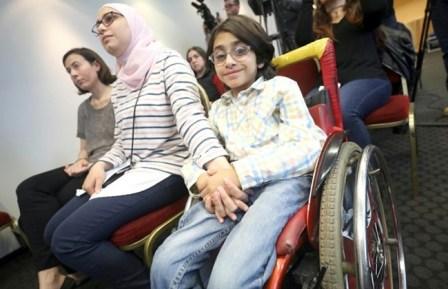
Every morning, 9-year-old Basmah throws a backpack over her shoulders and goes on a short car ride from her Akkar home to school, together with her siblings. Unlike them, however, she does not get to be dropped off. Basmah, who has Down syndrome, is one of 45,000 children between the ages of 5 and 14 who Human Rights Watch estimates to have a disability in Lebanon. According to a report released by the watchdog Thursday, many of them are likely to never set foot in a school.
“Our research found that the Social Affairs Ministry’s institution system is inadequate [as it] lacks a comprehensive plan to ... provide education to children with disabilities,” Sam Koplewicz, Satter Fellow at Human Rights Watch, said at the report launch in Beirut.
The newly released study, titled “I Would Like to Go to School,” is based on the experiences of 105 children and young adults with disabilities. The research found barriers to education to include lack of necessary infrastructure, absence of adequately trained teachers and discriminatory additional fees.
Some schools also refuse to accept children with disabilities for fear of the challenges their condition may pose. Basmah’s parents, for instance, told HRW that their daughter was denied enrollment because she “moves a lot.”
A limited number of children among those who are rejected by formal institutions end up enrolling in one of 103 ad hoc facilities funded by the Social Affairs Ministry.
However, they are not required to provide education, as education is not in the ministry’s mandate.
According to Lebanese law, the Education Ministry is responsible for guaranteeing equal opportunities within public and private educational facilities and covering the additional costs of the support for people with disabilities. HRW found the support granted by this ministry to have been so far insufficient.
Education Minister Marwan Hamadeh, who will meet HRW representatives to discuss the report Friday, assured The Daily Star that “huge efforts are being undertaken” to guarantee greater access to education. “We are recruiting specialists and putting a lot of [attention onto] the public sector,” Hamadeh said. While the minister was not immediately able to detail the pledged reforms, he made assurances he would provide figures at Friday’s meeting.
At present, however, HRW found the segregation of children with learning disabilities into separate institutions to likely be the case and advocated for greater inclusiveness.
“As a dyslexic myself, I can attest that inclusive education will provide others like me the opportunity to participate and thrive in society rather than being isolated,” Koplewicz said.
The few examples of inclusive education found across Lebanon seem to point to the same conclusion. In Nabatieh, Zebdine Public School made inclusivity its educational model. “The classes with children with disabilities are the most successful,” Khalil Zahri said in a video released by the watchdog to accompany the report.
Abbass Hamdan, an 11-year-old student at the school, has been studying alongside his peers for the past eight years despite being blind. At school they are “all friends,” he said in the video, where he appears running around through campus corridors alongside a classmate who offers him an arm to guide him.
Zahraa Samir, 11, who has no special needs, called on all schools to follow Zebdine’s model. “I don’t feel like they are so different,” she said, referring to children like Abbass.
The report launch was attended by Lebanese Association for Self Advocacy President Fadia Farah.
Most of the adults with disabilities helped by the organization have never attended school. “Those who have, it is only because of their parents,” she told The Daily Star.
Farah, whose 36-year-old daughter Mia today travels the world as the MENA representative for people with disabilities at Inclusion International, had to fight herself to see her child with Down syndrome enrolled in school. “I wanted her to go to the same school where my two boys went, so I spoke to the headmaster. He said: We don’t have the money. I told him I’d pay. ‘Everything?’ he asked. I was ready to do it,” Farah said. Back then, at the height of the Civil War, finding support was even harder. “There was no internet back then,” Farah recounted. “I had to wait for the electricity to come back and then start making calls.”
Eventually, she found a psychologist and a speech therapist who could support her daughter.
“Now I have to teach her how to stop talking,” Farah laughed.
Not all families, however, have the financial capabilities to assist their children to that extent, while others have to make huge sacrifices to make ends meet. In the video released by HRW, Hiba Chihab, mother of a boy confined to a wheelchair due to a neuroblastoma, said she and her husband work full time seven days a week to afford the additional fees related to support services.
Some families interviewed by Human Rights Watch said costs reached up to $13,000 a year of extra fees, on top of the regular private school tuition of $3,000 to $5,000.
“If we have to pay as single parents, [support is] very costly. But at school this would cost less because it is for more than one kid,” Farah said.
The United Nations estimates that children with disabilities constitute one third of the 121 million children at the primary and lower-secondary level who are out of school worldwide. In low income and lower-middle income countries, around 90 percent of children with disabilities do not have access to education.
Farah’s daughter addressed the United Nations in New York last year, giving a speech that she was able to formulate thanks to the support she received as a child. “If my daughter can do this, a lot of people with intellectual disabilities can,” Farah said. “But, I insist, they need support. And it is their right [to receive it].”
Source: The Daily Star
 FR
FR EN
EN AR
AR








